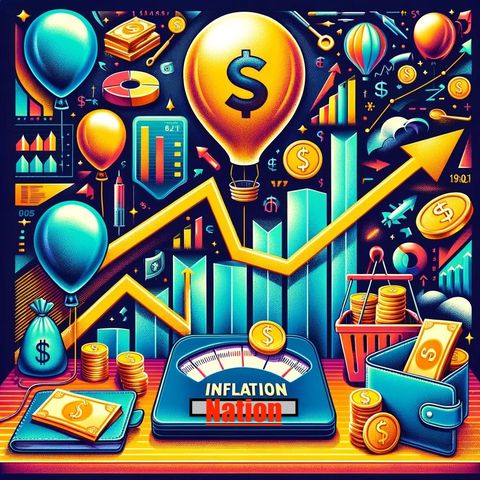Inflation Nation

Download and listen anywhere
Download your favorite episodes and enjoy them, wherever you are! Sign up or log in now to access offline listening.
Inflation Nation
This is an automatically generated transcript. Please note that complete accuracy is not guaranteed.
Description
Inflation, a fundamental economic concept, refers to the rate at which the general level of prices for goods and services is rising, and, subsequently, purchasing power is falling. Central banks...
show moreCauses of Inflation
Inflation is primarily caused by two phenomena: demand-pull inflation and cost-push inflation. A third cause, built-in inflation, ties into the expectations of consumers and workers.
1. Demand-Pull Inflation: This occurs when demand for goods and services exceeds supply, leading to an increase in prices. Factors that can lead to demand-pull inflation include increased consumer spending due to higher wages, government spending, and investment spending by companies. When more money chases a limited number of goods, prices naturally rise.
2. Cost-Push Inflation: Cost-push inflation happens when the costs of production increase, leading to a decrease in the supply of these goods. This can be due to rising labor costs, natural disasters affecting commodities, or increases in the prices of imports. Companies, facing higher costs, often pass these costs onto consumers in the form of higher prices.
3. Built-In Inflation: Also known as wage-price inflation, built-in inflation occurs when workers demand higher wages to keep up with living costs. Employers, in turn, pass these higher labor costs to consumers in the form of increased prices, leading to a cyclical inflation pattern.
Solutions to Inflation
Tackling inflation requires a multifaceted approach, often involving monetary policy, fiscal policy, and other economic measures.
1. Monetary Policy: Central banks, like the Federal Reserve in the United States, use monetary policy to control inflation. Key tools include adjusting interest rates, conducting open market operations, and modifying reserve requirements for banks. Raising interest rates can help reduce inflation by discouraging borrowing and spending, thus slowing down the economy.
2. Fiscal Policy: Governments can use fiscal policy to control inflation by reducing public spending or increasing taxes. By doing so, they can decrease the total amount of money circulating in the economy, thus reducing demand-pull inflation pressures.
3. Supply-Side Policies: Improving the efficiency of production can help manage cost-push inflation. This can involve reducing business regulations, investing in new technologies, or improving infrastructure to reduce production costs and increase supply.
What Can Be Done About Inflation?
Managing inflation effectively requires a balance between not stifling economic growth and not letting inflation run too high.
1. Independent Central Banks: Independent central banks can implement policies without political interference, focusing solely on economic indicators to guide their decisions on interest rates and inflation control.
2. Targeted Inflation Rates: Many central banks aim for a specific inflation target, usually around 2%. This provides the economy with a buffer against deflation without letting inflation spiral out of control.
3. Inflation Indexation: Some suggest indexing wages and pensions to inflation could help manage built-in inflation, as it adjusts incomes in line with price increases, potentially breaking the wage-price inflation cycle.
4. Global Cooperation: In an interconnected world economy, global cooperation can help manage inflation. International agreements on trade policies and commodity prices can help stabilize markets and prices worldwide.
Conclusion
Inflation is a complex phenomenon with no one-size-fits-all solution. It requires careful monitoring and a combination of policies tailored to the specific economic conditions of a country. While inflation can erode purchasing power, moderate inflation is a sign of a growing economy. The challenge for policymakers is to balance growth with stable prices to ensure economic stability and prosperity. Through a combination of monetary, fiscal, and supply-side measures, governments and central banks can manage inflation levels, ensuring that they contribute to, rather than detract from, economic health and the well-being of the population.
Thanks for listening to Quiet Please. Remember to like and share wherever you get your podcasts. And Hey! History buffs, buckle up! Talking Time Machine isn't your dusty textbook lecture. It's where cutting-edge AI throws wild interview parties with history's iconic figures. In the Talking Time Machine podcast: History Gets a High-Tech Twist, Imagine: Napoleon Bonaparte talking French Politics with Louis the 14th! This podcast is futuristically insightful. Our AI host grills historical legends with questions based on real historical context, leading to surprising, thought-provoking, and often mind-blowing answers. Whether you're a history geek, a tech junkie, or just love a good interview, Talking Time Machine has something for you. Talking Time Machine: search, subscribe, and (Listen Now!)
Information
| Author | QP-2 |
| Organization | William Corbin |
| Website | - |
| Tags |
Copyright 2024 - Spreaker Inc. an iHeartMedia Company

Comments